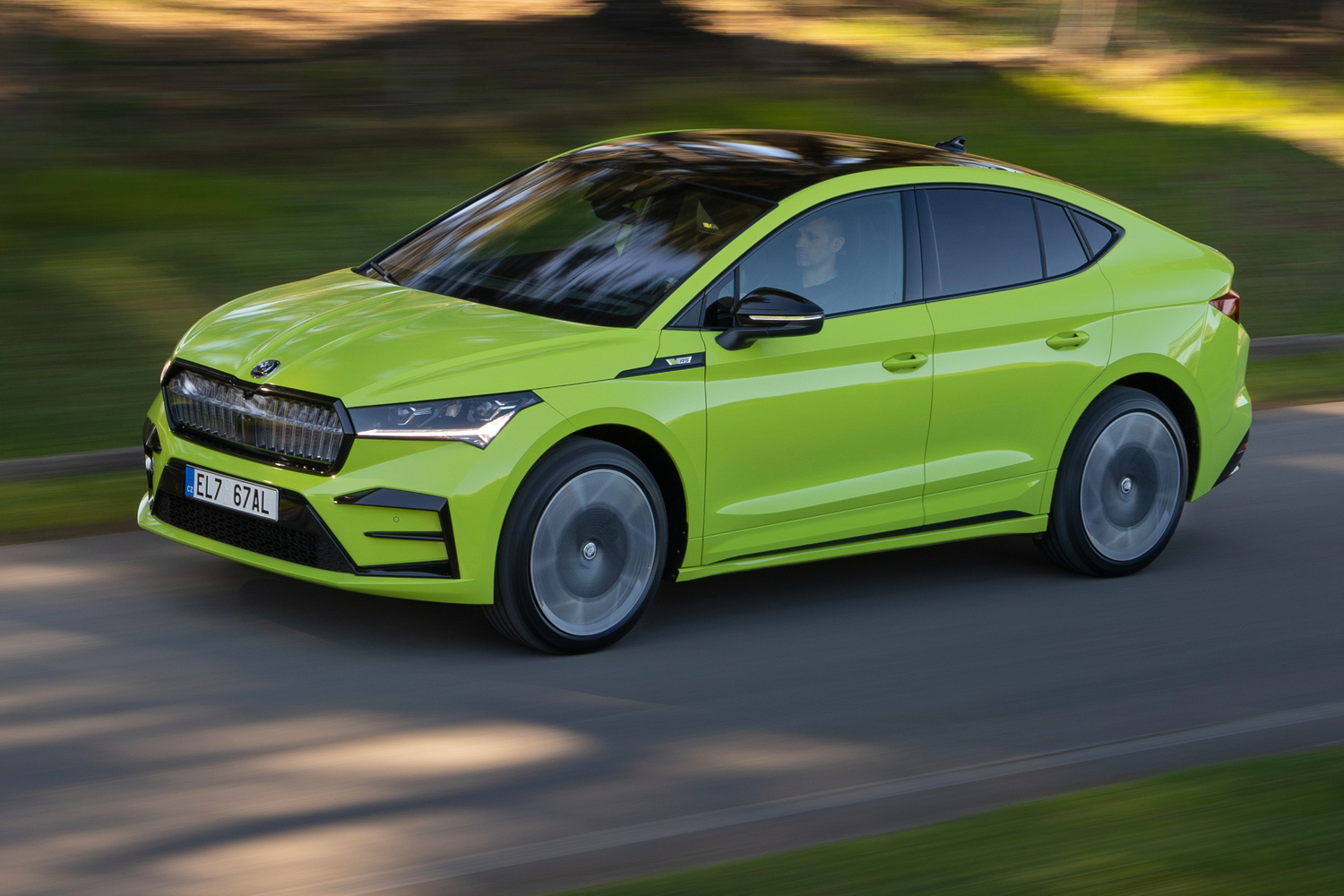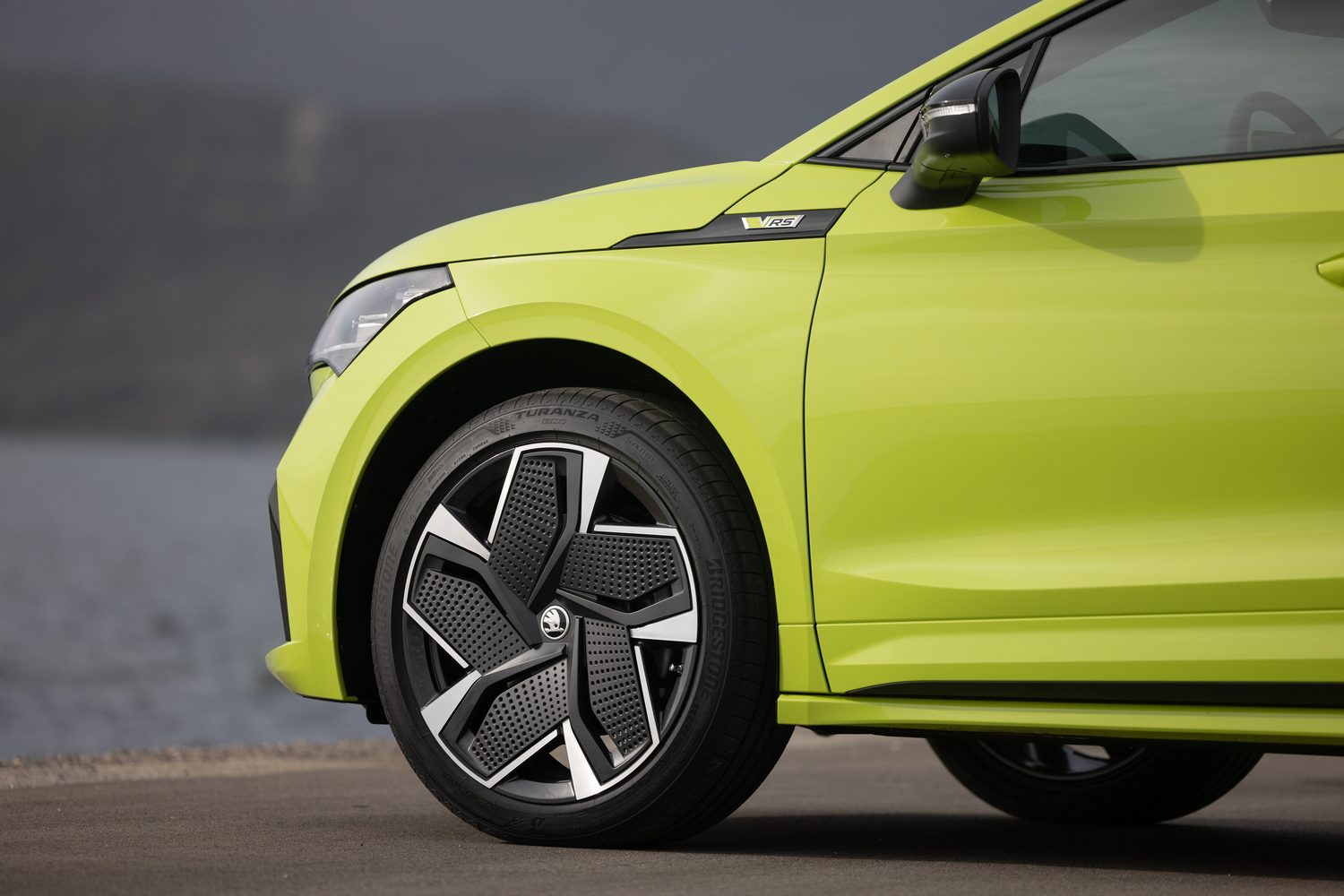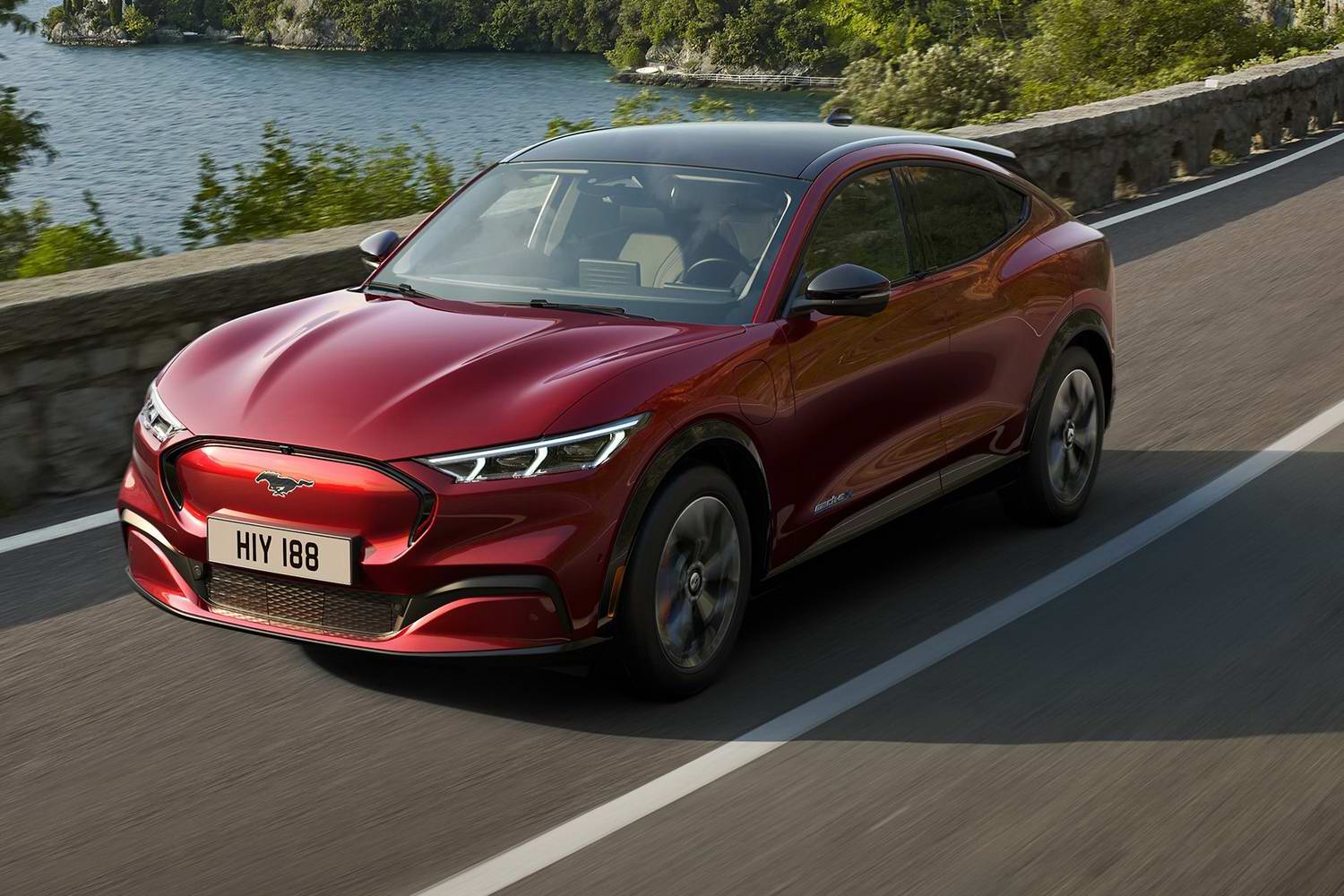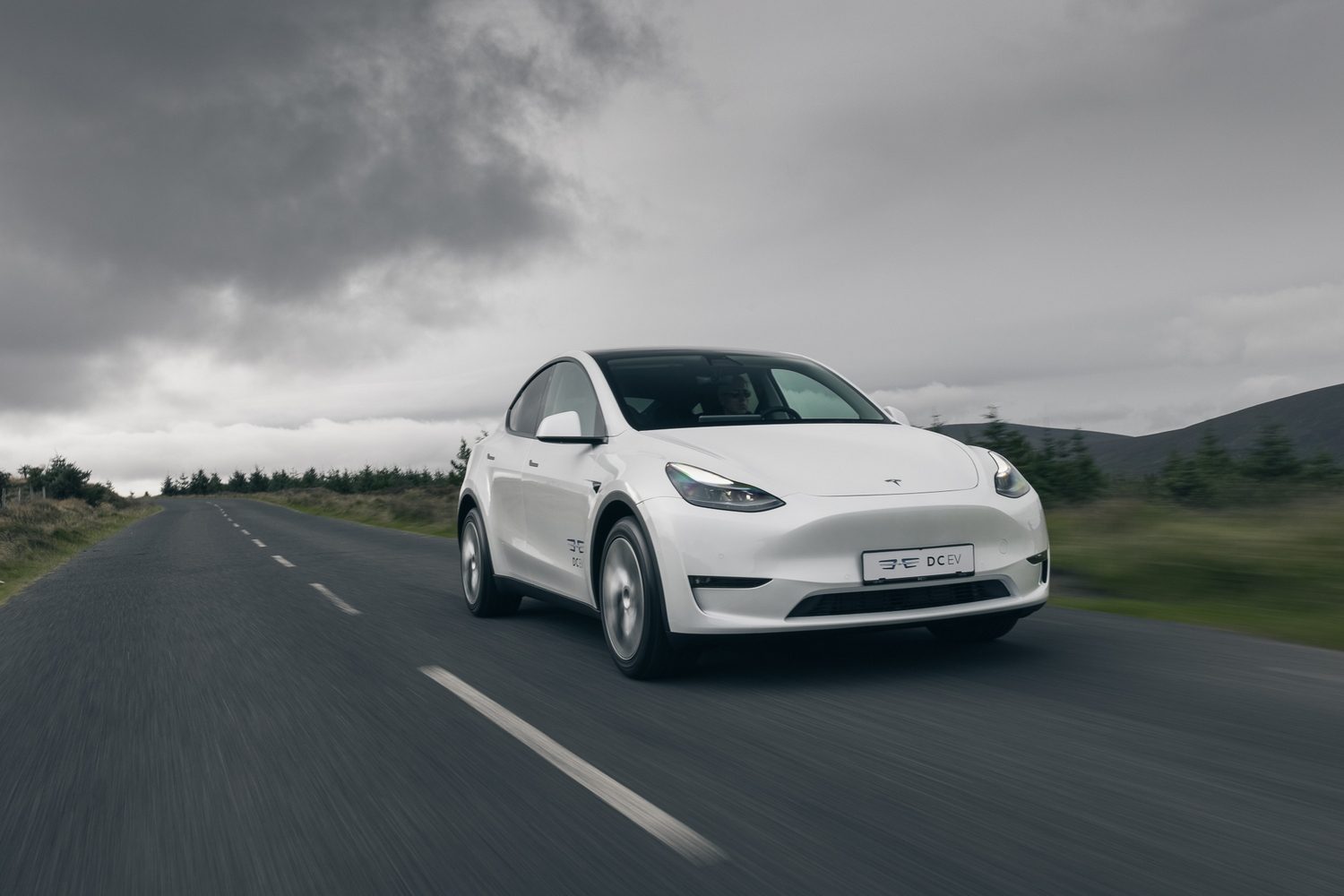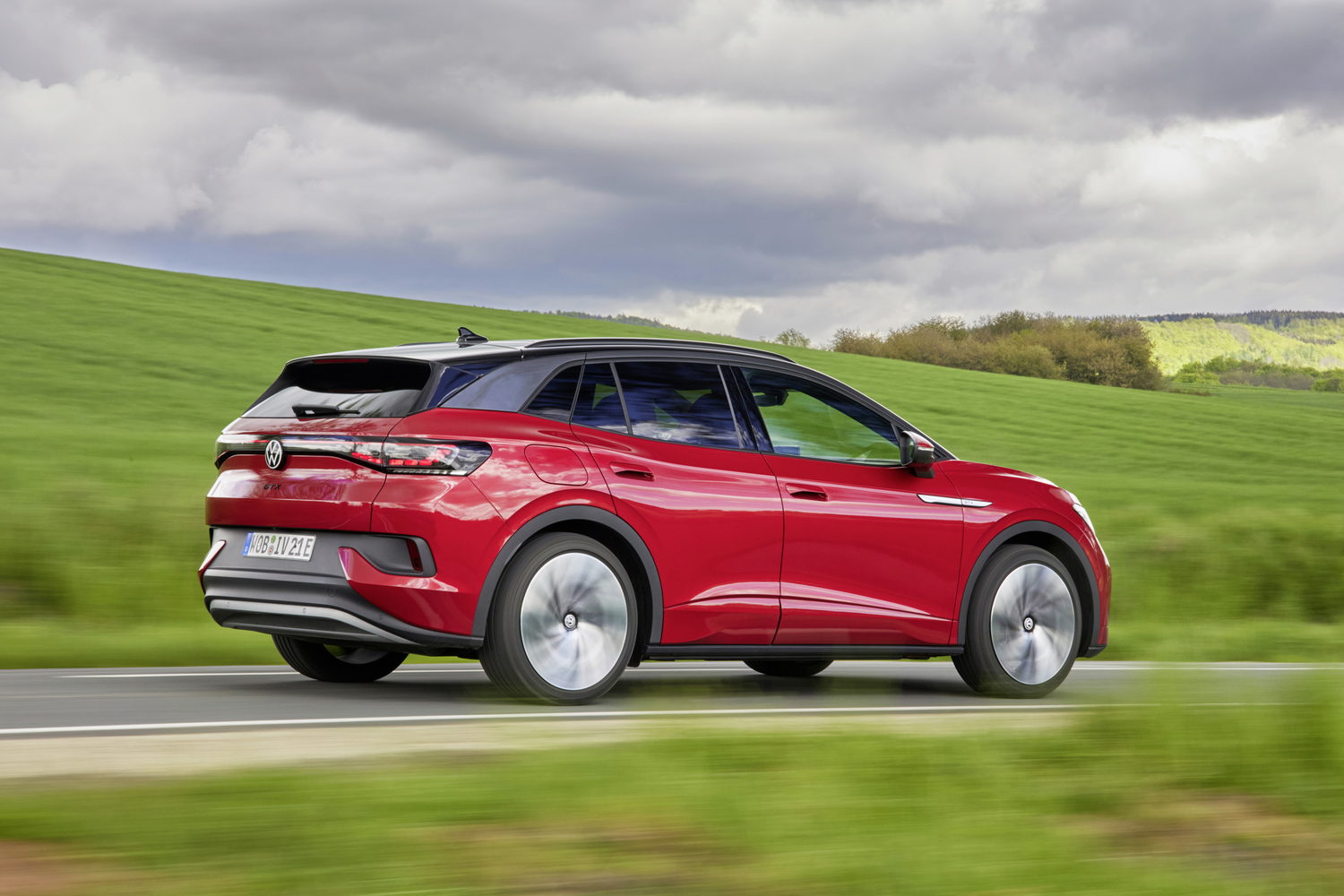Skoda is expanding its popular electric Enyaq line-up with a 'coupe' body style, and a high-performance RS model. Is it quick enough to live up to its sporty billing, though?
In the metal
The Hyper Green paintwork of our test car really makes the Enyaq RS. It's an exclusive colour to the sportiest version of Skoda's chopped-roof electric SUV-coupe and, while it's probably a bit too wild for most - not to mention a beacon for all Garda Traffic units in the vicinity - it combines with the RS's black exterior trim to great effect. In fact, put laces up the windscreen and it would look like a massively fashionable trainer...
It's a good-looking car, the Enyaq Coupe. Making a coupe out of an SUV is an often-fraught visual business - just look at the BMW X4 and X6 for proof - but Skoda has made a good fist of trimming the roofline of the Enyaq. From most angles, it's really handsome and only looks awkward and a bit pinched-in if you look from directly behind.
There are some visual tweaks other than the sharply sloped rear roof and tailgate - the black plastic sills of the regular Enyaq are now body-coloured, which makes it look a little chunkier and more imposing, while all Enyaq Coupes get a full-length glass roof. This RS model also gets, as standard, the 'Crystal Face' light-up grille, which is either rather endearing or horribly tacky, depending on your personal taste. The optional dark-finished 21-inch wheels worn by our test car are of rather more universal appeal.
Inside, the cabin is as per that of the regular Enyaq, which is to say it's excellent. In fact, I'd go so far as to say that I prefer it to the cabins of either the closely-related VW ID.4 or the Audi Q4 e-tron. Build quality is excellent, and the control layout seems a little more sensible than that of the VW, and more distinctive than that of the Audi.
In the centre of the dashboard, there's a big 13-inch touchscreen that gets upgraded software to improve the menu layout a bit, and seems to remove the lag between pressing the screen and getting a response that occasionally afflicted the early Enyaqs and ID models. The RS gets wonderfully comfortable and supportive high-backed bucket seats, while there's a generous helping of synthetic suede for the dashboard, which definitely lifts the cabin ambience. The centre console has plenty of storage spaces, although the stubby little drive selector seems to take up slightly more space than it should. The main instruments are on a small, inset screen behind the wheel but you'll probably mostly use the head-up display, which projects speed and usefully large, blue, navigation arrows onto the windscreen.
Even with the chopped rear roofline, Skoda claims that there's as much headroom in the back of the Coupe as in the regular Enyaq, although obviously it does feel a little snugger, what with the roof being physically closer to you. That big glass roof does without a sunblind, using thermal protection instead, and that helps with the headroom, but to be honest I'd prefer a physical blind of some sort. You can get three people sitting side by side in the back (the flat floor helps) but the one sitting in the middle will inevitably be somewhat less comfortable than those in the outer seats.
On the tech front, there are four USB-C sockets (two in the front and two in the back) and a wireless charging pad for your phone. The big screen gets wireless Apple CarPlay and Android Auto, as well as Skoda's own connected internet services, plus over-the-air software updates (that comes with the new software, which debuts on the Coupe - older Enyaq owners can upgrade to the new software, at a dealership, later this year). The navigation is a little cleverer now, and is able to work in charging stops for longer journeys, as well as allowing you to choose which charging providers you prefer.
Driving it
Being based on the same electric package - and MEB platform - as the Volkswagen ID.4 GTX and Audi Q4 e-tron 50 quattro, it's hardly a surprise that the Enyaq RS Coupe matches the power and torque outputs of those two, at 299hp and 460Nm of torque. Like the other two, there's an extra electric motor, mounted in the front, which gives the Enyaq RS four-wheel drive and the ability to power the wheels best able to cope with it.
That makes for effortless progress - put your foot down hard, and on anything but the most hopelessly slippery surface, the Enyaq RS will glide forward with not even a hint of wheelspin nor hesitation. The 6.5-second 0-100km/h time is decent, if not especially thrilling, and that's a good way to describe the overall performance. There's an initial instant surge of electric power as you step on the accelerator, but it soon tails off as the speed picks up. It's fine, and certainly not slow, but lacks the addictive thump of performance that you get from, say, the Tesla Model Y or the AWD versions of the Ford Mustang Mach-E. The Enyaq RS actually has a slightly higher top speed than the regular model, and the 204hp rear-drive Enyaq Coupe - 180km/h versus 160km/h - but that's obviously of rather limited importance in an Irish context.
Of much more import is the range. Thanks to being more slippery through the air, the regular Enyaq Coupe actually has a fractionally longer range than the boxier SUV model - 540km on a full charge of its 77kWh (usable) battery instead of 520km. Being as it's heavier and has more power, needless to say the RS version can't match that, but it does come with a still-very-decent official 500km range on one charge. In real-world conditions, that will probably fall to more like 420km, or maybe as low as 370km if it's very cold out and the battery (and occupants) need heating up. The software update has liberated a more rapid charging ability, and you can charge the Enyaq RS Coupe (and the regular Coupe) at speeds of up to 135kW (up from 125kW) if you can find a fast enough public charging point. That will get you from 5-80 per cent battery power in about 36 minutes.
The official electric consumption of 17.5kWh/100km is pretty believable too - although you'd have to be pretty reticent with the RS's power to achieve that, you should expect to get around 20-22kWh/100km in daily driving.
Where the Enyaq RS falls down a little is in its handling. It's certainly not a bad car to drive, and shares the standard model's combination of excellent refinement and rock-solid stability. What it lacks is a proper sense of RS-appropriate fun. The RS Coupe (and the standard Enyaq Coupe) sit lower and stiffer on their springs than a standard Enyaq, and that means that they ride a bit more stiffly too. It's not a terrible ride quality, but it's more noticeable than in the standard, smooth, Enyaq. The 21-inch wheels probably don't help, so you might be well advised to stick to the standard 19-inch rims on the regular Enyaq Coupe, or the 20-inch wheels of the RS. There is adaptive suspension available as an option, and in Comfort mode you can dial out some of the extra stiffness, but it never goes away entirely.
Switch to Sport mode and the Enyaq RS definitely starts to feel a little tauter, and - with the front motor chiming in all the time, rather than on-demand in Comfort and Normal modes - a little more responsive. The well-weighted, but numb, steering seems initially to guide the nose tight into a chosen apex, but then the car's weight - 2.3 tonnes at the kerb - starts to trigger ever-stronger understeer and so the Enyaq RS doesn't actually feel all that much fun to drive. Quick? Certainly. Satisfying? Definitely. Fun? Not really, and that's a problem - you're going to be paying significantly more for that RS badge than for the standard, equally-handsome, Enyaq Coupe, but not really getting more useable performance. The 204hp version is barely any slower in subjective terms, and while it doesn't have the versatility of all-wheel drive, it's still a very satisfying car to steer. The RS model has handling that's a little sharper, and feels a bit more agile and responsive in Sport mode, but it hardly seems worth the extra for that alone to be honest.
What you get for your money
We don't know yet what Irish prices will be set for either the Enyaq Coupe or the Enyaq RS Coupe, but going by other markets, it could be slightly more expensive than the equivalent Volkswagen ID.4 GTX. You will get copious amounts of equipment - including the 'Crystal Face' grille, 20-inch alloys, the glass roof, a powered tailgate, the 13-inch touchscreen and heated seats both front and rear - but key items such as the Canton stereo and the 21-inch alloys will be on the options list. Given that the standard, 204hp, rear-drive Enyaq Coupe has the same handsome looks as the RS, and offers an additional 40km of one-charge range, we reckon the sensible money will go on the standard version.
Summary
The Skoda Enyaq RS Coupe suffers from the same problem as its cousin, the VW ID.4 GTX - it's just too heavy to be much fun to drive, and really, Skoda should have given it a badge other than RS. Maybe Enyaq Monte Carlo would have been more suitable? That said, it's still a very tempting purchase, with great looks, a fab cabin, plenty of space and excellent electric performance and range.

